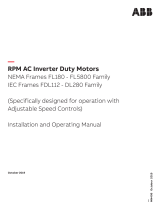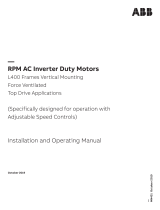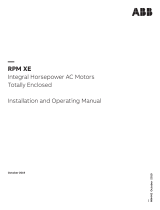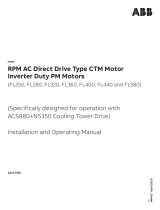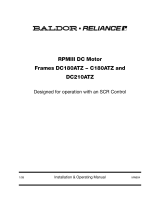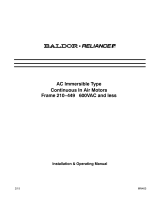Page is loading ...

6/13 Installation & Operating Manual MN434
RPM Insulation Systems
Evaluation and Maintenance Guidelines

Any trademarks used in this manual are the property of their respective owners.
Important:
Be sure to check www.baldor.com for the latest software, rmware and drivers for your VS1SD product. Also you can
download the latest version of this manual in Adobe Acrobat PDF format.
Section 1
General Information ................................................................. 1-1
Overview .......................................................................... 1-1
Safety Notice: . . . . . . . . . . . . . . . . . . . . . . . . . . . . . . . . . . . . . . . . . . . . . . . . . . . . . . . . . . . . . . . . . . . . . . . 1-1
Section 2
Test Procedures .................................................................... 2-1
Insulation System Resistance Measurement ............................................... 2-1
Polarization Index Test Procedure ....................................................... 2-1
Report For IEEE429 Dielectric Withstand TEST IN AIR .................................... 2-2
Procedure for the Examination and Routine Motor Maintenance ........................... 2-2
Table of Contents

1-1MN434
Section 1
General Information
Overview This manual contains general procedures that apply to Baldor Motor products. Be sure to read and understand
the Safety Notice statements in this manual. For your protection, do not install, operate or attempt to perform
maintenance procedures until you understand the Warning and Caution statements.
A Warning statement indicates a possible unsafe condition that can cause harm to personnel.
A Caution statement indicates a condition that can cause damage to equipment.
Important: This instruction manual is not intended to include a comprehensive listing of all details for all procedures required
for installation, operation and maintenance. This manual describes general guidelines that apply to most of the
motor products shipped by Baldor. If you have a question about a procedure or are uncertain about any detail,
Do Not Proceed. Please contact your Baldor District Ofce for more information or clarication.
Before you install, operate or perform maintenance, become familiar with the following:
• NEMA Publication MG-2, Safety Standard for Construction and guide for Selection, Installation and
Use of Electric Motors and Generators.
• IEC 34−1 Electrical and IEC72−1 Mechanical specications
• ANSI C51.5, the National Electrical Code (NEC) and local codes and practices.
Safety Notice: This equipment contains high voltage! Electrical shock can cause serious or fatal injury. Only qualied personnel
should attempt installation, operation and maintenance of electrical equipment.
Be sure that you are completely familiar with NEMA publication MG-2, safety standards for construction and
guide for selection, installation and use of electric motors and generators, the National Electrical Code, IEC and
local codes and practices. Unsafe installation or use can cause conditions that lead to serious or fatal injury.
Only qualied personnel should attempt the installation, operation and maintenance of this equipment.
WARNING: Do not touch electrical connections before you first ensure that power has been disconnected. Electrical
shock can cause serious or fatal injury. Only qualified personnel should attempt the installation, operation
and maintenance of this equipment.
WARNING: Disconnect all electrical power from the motor windings and accessory devices before disassembling of
the motor. Electrical shock can cause serious or fatal injury.
WARNING: Be sure the system is properly grounded before applying power. Do not apply AC power before you ensure
that all grounding instructions have been followed. Electrical shock can cause serious or fatal injury.
WARNING: Avoid extended exposure to machinery with high noise levels. Be sure to wear ear protective devices to
reduce harmful effects to your hearing.
WARNING: Surface temperatures of motor enclosures may reach temperatures which can cause discomfort or injury
to personnel accidentally coming into contact with hot surfaces. When installing, protection should be
provided by the user to protect against accidental contact with hot surfaces. Failure to observe this
precaution could result in bodily injury.
WARNING: This equipment may be connected to other machinery that has rotating parts or parts that are driven by
this equipment. Improper use can cause serious or fatal injury. Only qualified personnel should attempt to
install operate or maintain this equipment.
WARNING: Do not by-pass or disable protective devices or safety guards. Safety features are designed to prevent
damage to personnel or equipment. These devices can only provide protection if they remain operative.
WARNING: Avoid the use of automatic reset devices if the automatic restarting of equipment can be hazardous to
personnel or equipment.
WARNING: Incorrect motor rotation direction can cause serious or fatal injury or equipment damage. Be sure to verify
motor rotation direction before coupling the load to the motor shaft.
WARNING: Be sure the load is properly coupled to the motor shaft before applying power. The shaft key must be
fully captive by the load device. Improper coupling can cause harm to personnel or equipment if the load
decouples from the shaft during operation.
WARNING: Use proper care and procedures that are safe during handling, lifting, installing, operating and maintaining
operations. Improper methods may cause muscle strain or other harm.
WARNING: Incorrect motor rotation direction can cause serious or fatal injury or equipment damage. Be sure to verify
motor rotation direction before coupling the load to the motor shaft.
WARNING: Motors that are to be used in flammable and/or explosive atmospheres must display the CSA listed logo.
Specific service conditions for these motors are defined in NFPA 70 (NEC) Article 500.
WARNING: Pacemaker danger − Magnetic and electromagnetic fields in the vicinity of current carrying conductors
and permanent magnet motors can result in a serious health hazard to persons with cardiac pacemakers,
metal implants, and hearing aids. To avoid risk, stay way from the area surrounding a permanent magnet
motor.
WARNING: RPM AC permanent magnet motors can induce voltage and current in the motor leads by rotating the
motor shaft. Electrical shock can cause serious or fatal injury. Therefore, do not couple the load to the
motor shaft until all motor connections have been made. During any maintenance inspections, be sure the
motor shaft will not rotate.
WARNING: Before performing any motor maintenance procedure, be sure that the equipment connected to the motor
shaft cannot cause shaft rotation. If the load can cause shaft rotation, disconnect the load from the motor
shaft before maintenance is performed. Unexpected mechanical rotation of the motor parts can cause
injury or motor damage.
WARNING: Do not use non UL/CSA listed explosion proof motors in the presence of flammable or combustible vapors
or dust. These motors are not designed for atmospheric conditions that require explosion proof operation.
WARNING: UL Listed motors must only be serviced by UL Approved Authorized Baldor Service Centers if these
motors are to be returned to a hazardous and/or explosive atmosphere.

1-2 MN434
Safety Notice Continued
WARNING: Guards must be installed for rotating parts such as couplings, pulleys, external fans, and unused shaft
extensions, should be permanently guarded to prevent accidental contact by personnel. Accidental
contact with body parts or clothing can cause serious or fatal injury.
WARNING: C−Face motor is intended for mounting auxiliary equipment such as pumps and gears. When mounted
horizontally Frames FL, RL and L280C thru L360C, (FDL, RDL and DL180Y−DL220Y) and frames L400D
thru L4461D, DL250Y − DL280Y must be supported by the feet and not by the C−Face on D−Flange
alone. C−Face motors should be supported by the feet and not by the C−Face. Installations requiring
a horizontally mounted motor in frames L280C − L440D, FDL, DL180Y−DL280Y must be supported by
the feet as well as C−Face, D− Flange or IEC Flange. Failure to observe these precautions can result in
bodily injury and equipment damage.
Warning: RPM AC permanent magnet motors can induce voltage and current in the motor leads by rotation of the
motor shaft even with the motor disconnected from line power. Electrical shock can cause serious or
fatal injury. Therefore, do not couple the load to the motor shaft until all motor connections have been
made. During any maintenance inspections, be sure the motor shaft will not rotate.
Caution: Use only a shielded motor power cable with a complete circumferential braided or copper film/tape
ground jacket around the power leads. This ground should be secured to the motor frame from within
the motor terminal box and must return without interruption to the drive ground. In addition, if the
motor and coupled equipment are not on a single common metal base plate, it is important to equalize
the equipment ground potentials by bonding the motor frame to the coupled equipment using a high
frequency conductor such as a braided strap.
Caution: Do not over−lubricate motor as this may cause premature bearing failure.
Caution: Do not lift the motor and its driven load by the motor lifting hardware. The motor lifting hardware is
dequate for lifting only the motor. Disconnect the load (gears, pumps, compressors, or other driven
equipment) from the motor shaft before lifting the motor.
Caution: If eye bolts are used for lifting a motor, be sure they are securely tightened. The lifting direction should
not exceed a 20° angle from the shank of the eye bolt or lifting lug. Excessive lifting angles can cause
damage.
Caution: To prevent equipment damage, be sure that the electrical service is not capable of delivering more than
the maximum motor rated amps listed on the rating plate.
Caution: If a HI POT test (High Potential Insulation test) must be performed, follow the precautions and procedure
in NEMA MG1 and MG2 standards to avoid equipment damage.
Caution: Do not use an induction oven to heat noise tested bearings. Arcing between the balls and races may
damage the bearing. Failure to observe this precaution may result in equipment damage.
Caution: Do not operate motors with a roller bearing unless a radial load is applied so that damage to the roller
bearing does not occur.
Caution: RPM AC permanent magnet motors with an open enclosure, such as DP−FV, should not be used where
ferrous dust or particles may be present . Totally enclosed permanent magnet motors are recommended
for these applications.
Caution: Excessive varnish build can cause motor overheating and damage. Varnish builds up on the winding coil
heads and restricts cooling of the coils and end turns. Avoid adding excessive varnish to stator winding.
If you have any questions or are uncertain about any statement or procedure, or if you require additional
information please contact your Baldor District ofce or an Authorized Baldor Service Center.

2-1MN434
Section 2
Test Procedures
Insulation System Resistance Measurement
A key requirement to achieving proper motor life is the condition of the insulation system. A clean and dry
insulation system that is maintained within the thermal limitations according to the insulation class will provide
proper motor life. When motors are being used in harsh environments and moisture and contamination are
being introduced into the motor winding, it is imperative to perform a maintenance regimen to determine the
health of the insulation system and to take steps as necessary to keep the inside of the motor clean and dry.
Insulation resistance measurement has been utilized successfully for many years to evaluate the condition of
the electrical insulation. Periodic measurements should be taken and records of the results should be kept to
analyze the measurement results and to especially determine if a signicant decrease in the insulation resistance
has occurred. Testing should be performed according to the latest revision of IEEE 43. This document provides
detailed guidelines for performing the test and how to analyze the results.
IEEE 43 Recommended Practice for Testing Insulation Resistance of Rotating Machinery.
The insulation resistance measurement is performed by applying a DC voltage to the stator winding and
measuring the resistance between the winding and ground. The guidelines for the DC voltage to be applied are:
Rated Motor Voltage Recommended DC Test Voltage
<1000 500
1001 - 2500 500 - 1000
For insulation in good condition and in a dry state, the insulation resistance will be essentially the same for a test
voltage of 500 VDC or 1000 VDC. A signicant decrease in the insulation resistance when an increased voltage is
applied may be an indication of insulation problems.
The measured insulation resistance of a motor winding will normally increase with the duration of application of
the direct test potential. The increase will usually be rapid when the potential is rst applied, and the readings
gradually approach a fairly constant value as time elapses. The measured insulation resistance of a dry winding
in good condition may continue to increase for hours with constant test potential continuously applied; however,
a fairly steady value is usually reached in 10 to 15 minutes. If the winding is wet or dirty, the steady value will
usually be reached in one or two minutes after the test potential is applied. The slope of the curve is an indication
of insulation condition. The polarization index is the ratio of the 10 minute resistance value to the 1 minute
resistance value. The polarization index is indicative of the slope of the characteristic curve (resistance on the
y axis versus time on the x axis using a y – log and x- log scale). The polarization index may be useful in the
appraisal of the winding for dryness and for tness for over-potential test. The 1 minute insulation resistance is
useful for evaluating insulation condition where comparisons are to be made with earlier and later data, similarly
obtained.
Insulation resistance measurements are affected by several factors including surface condition, moisture,
temperature, magnitude of test direct potential, duration of the application of test direct potential and residual
charge in the winding.
Insulation resistance of a winding is not directly related to its dielectric strength. It is impossible to specify the
value of insulation resistance at which a winding will fail electrically.
If the polarization index is reduced because of dirt or excessive moisture, it can be brought up to proper value by
cleaning and drying to remove moisture.
The IEEE recommended minimum value of polarization index for Class B, F and H motors is 2.0.
Polarization Index Test Procedure
1. Discharge the winding by grounding the motor power leads.
2. It has been proven that when power terminal connection blocks are used this has a signicant negative
impact on obtaining an accurate insulation resistance measurement. Therefore, it is necessary for the motor
power leads to be disconnected from the terminal block before performing the insulation resistance test. The
readings must be taken in the same manner each time to be able to compare results.
3. The winding temperature must be known.
4. Apply voltage to the winding without interruption for 10 minutes. Record the insulation resistance value after
voltage has been applied for 1 minute and then at the 10 minute mark. Do not take a measurement at less
than 1 minute.
5. Insulation test values should be corrected to a common base temperature of 40 ºC.
The correction may be made using the Equation: K
c
= K
T
R
T
where
R
c
is insulation resistance (in megohms) corrected to 40 °C,
K
T
is insulation resistance temperature coefcient at temperature T°C (from 6.3.2 or 6.3.3),
R
T
is measured insulation resistance (in megohms) at temperature T°C.
For winding temperatures less than the dew point, it is difcult to predict the effect of moisture condensation
on the surface. Therefore an attempt to correct to 40 °C for trend analysis would introduce an unacceptable
error.
In such cases, it is recommended that the history of the machine tested under similar conditions be the
predominant factor in determining suitability for return to service. However, since moisture contamination
normally reduces the insulation resistance and/or polarization index readings, it is possible to correct to 40
°C for comparison against the acceptance criteria (see Clause 12).

2-2 MN434
K
T
can also be approximated for insulation resistance halving for a 10 °C rise in winding temperature by
application of this next equation.
For example, if the winding temperature at test time was 35 °C, and the insulation was such that the
resistance halved for every 10 °C, then the Kt for correction to 40 °C would be derived in the following way:
K
T
= (0.5)
or
K
T
= (0.5) (40-35)/10 = (0.5) 5/10 = (0.5) 1/2 = 0.707
6. The polarization index is the 10 minute reading divided by the 1 minute reading.
7. Discharge the power leads at the conclusion of the test.
An IEEE429 Dielectric Withstand test and report including the polarization index can be provided from the
manufacturing plant for new motors in order for the customer to establish a base line value. The test report will
include the following information.
REPORT FOR IEEE429 Dielectric Withstand TEST IN AIR
IDENTIFICATION NUMBER: __________ UNIT: __________
TESTER: __________ DATE: __________ MOTOR VOLTAGE: __________
INSULATION RESISTANCE CORRECTED TO 40 °C AMBIENT
AT ONE MINUTE: __________
AT TEN MINUTE: __________
POLARIZATION INDEX: __________
CERTIFIED BY: ________________________________________
DATE: __________
Procedure for the Examination and Routine Motor Maintenance
1. Inspect the motor at regular intervals, approximately every 500 hours of operation or every 3 months. If the
environment is abnormally harsh with a potential for excessive contamination, the interval period may need
to be less. Keep the motor clean and the ventilation openings clear. If the motor is not properly ventilated,
overheating can occur and cause early motor failure.
2. Examine exterior of motor for defects, cracks, contamination and any other condition that is different from
the condition of the motor as originally shipped. Pay particular attention to grease ttings, grease drains, end
rings, and condensate drain holes. Record ndings and take pictures.
3. Access motor leads and perform 500 VDC Dielectric Withstand Test. Record readings at 1 minute and 10
minutes to calculate polarization index.
4. Analyze the insulation resistance readings to determine if the motor needs to be removed from service for
maintenance. It is recommended to remove the motor from service and perform maintenance on the motor if
the 1 minute reading is less than 5 MΩ when corrected to 40 °C or if the polarization index is less than 2.0 or
if there is a signicant decrease in the values when compared to previous tests.
5. If the motor is removed from service for maintenance, measure the shaft extension for total indicator run
out and record any damage to the shaft taper that may exist before disassembly of the motor. Record
measurements. Take pictures if necessary.
6. Once the motor is disassembled, thoroughly examine all parts of the motor for obvious defects or damage.
Examine bearings, bearing cavities, shaft bearing journals, seals, bracket drain holes, stator winding, rotor,
shaft, motor leads, terminal strip, and stator core. Measure shaft bearing journals and bracket bearing
cavities and record measurements.
Compare to part drawings. Examine grease for contamination. Record ndings and take pictures.
7. If the winding and/or core are contaminated, pressure cleaning may be required. Visual inspection and the
insulation resistance test results will help determine if cleaning is required.
8. If the insulation resistance is low but a visual inspection does not reveal heavy contamination, the culprit may
be moisture. If that is the case, the stator core and winding may be dried out by placing the stator in an oven
at 250 °F - 275 °F for seven hours.
CAUTION: Excessive varnish build can cause motor overheating and damage. Varnish builds up on the winding coil
heads and restricts cooling of the coils and end turns. Avoid adding excessive varnish to stator winding.
9. Once the stator has been cleaned and dried, perform a thorough visual examination to look for cracks in
the varnish and any possible scratches and nicks on wires. If the examination reveals any cracks, nicks or
scratches, adding an overcoat of a thin varnish for repair is acceptable.
10. Perform an insulation resistance test on the cleaned, dried, and repaired stator to obtain the 1 minute and
10 minute values to validate the repairs. Record the values for future comparison with values obtained in the
eld.
Since the motor has been disassembled, the bearings and all seals should be replaced at this time. The brackets
and bearing caps should be washed to remove all grease and contamination.


© Baldor Electric Company
MN434
All Rights Reserved. Printed in USA.
6/13
Baldor Electric Company
P.O. Box 2400, Fort Smith, AR 72902-2400 U.S.A., Ph: (1) 479.646.4711, Fax (1) 479.648.5792, International Fax (1) 479.648.5895
www.baldor.com
/

